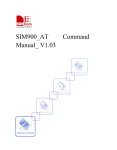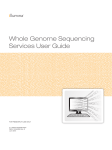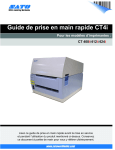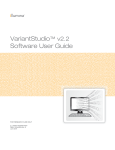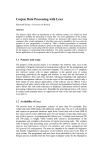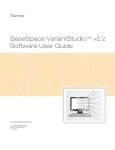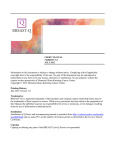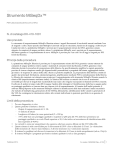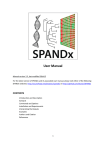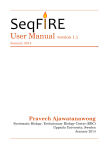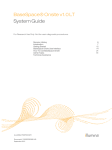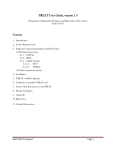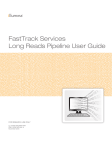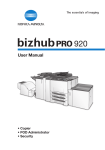Download Cancer Analysis Service User Guide - Support
Transcript
Cancer Analysis Services
User Guide
FOR RESEARCH USE ONLY
ILLUMINA PROPRIETARY
Part # 15040893 Rev. C
June 2015
This document and its contents are proprietary to Illumina, Inc. and its affiliates ("Illumina"), and are intended solely for the
contractual use of its customer in connection with the use of the product(s) described herein and for no other purpose. This
document and its contents shall not be used or distributed for any other purpose and/or otherwise communicated, disclosed,
or reproduced in any way whatsoever without the prior written consent of Illumina. Illumina does not convey any license
under its patent, trademark, copyright, or common-law rights nor similar rights of any third parties by this document.
The instructions in this document must be strictly and explicitly followed by qualified and properly trained personnel in order
to ensure the proper and safe use of the product(s) described herein. All of the contents of this document must be fully read
and understood prior to using such product(s).
FAILURE TO COMPLETELY READ AND EXPLICITLY FOLLOW ALL OF THE INSTRUCTIONS CONTAINED HEREIN
MAY RESULT IN DAMAGE TO THE PRODUCT(S), INJURY TO PERSONS, INCLUDING TO USERS OR OTHERS, AND
DAMAGE TO OTHER PROPERTY.
ILLUMINA DOES NOT ASSUME ANY LIABILITY ARISING OUT OF THE IMPROPER USE OF THE PRODUCT(S)
DESCRIBED HEREIN (INCLUDING PARTS THEREOF OR SOFTWARE).
© 2015 Illumina, Inc. All rights reserved.
Illumina, 24sure, BaseSpace, BeadArray, BlueFish, BlueFuse, BlueGnome, cBot, CSPro, CytoChip, DesignStudio,
Epicentre, GAIIx, Genetic Energy, Genome Analyzer, GenomeStudio, GoldenGate, HiScan, HiSeq, HiSeq X, Infinium,
iScan, iSelect, ForenSeq, MiSeq, MiSeqDx, MiSeq FGx, NeoPrep, Nextera, NextBio, NextSeq, Powered by Illumina,
SeqMonitor, SureMDA, TruGenome, TruSeq, TruSight, Understand Your Genome, UYG, VeraCode, verifi, VeriSeq, the
pumpkin orange color, and the streaming bases design are trademarks of Illumina, Inc. and/or its affiliate(s) in the U.S. and/or
other countries. All other names, logos, and other trademarks are the property of their respective owners.
Read Before Using this Product
This Product, and its use and disposition, is subject to the following terms and conditions. If Purchaser does not agree to these
terms and conditions then Purchaser is not authorized by Illumina to use this Product and Purchaser must not use this Product.
1
Definitions. "Application Specific IP" means Illumina owned or controlled intellectual property rights that pertain to
this Product (and use thereof) only with regard to specific field(s) or specific application(s). Application Specific IP
excludes all Illumina owned or controlled intellectual property that cover aspects or features of this Product (or use
thereof) that are common to this Product in all possible applications and all possible fields of use (the "Core IP").
Application Specific IP and Core IP are separate, non-overlapping, subsets of all Illumina owned or controlled intellectual
property. By way of non-limiting example, Illumina intellectual property rights for specific diagnostic methods, for
specific forensic methods, or for specific nucleic acid biomarkers, sequences, or combinations of biomarkers or
sequences are examples of Application Specific IP. "Consumable(s)" means Illumina branded reagents and consumable
items that are intended by Illumina for use with, and are to be consumed through the use of, Hardware.
"Documentation" means Illumina's user manual for this Product, including without limitation, package inserts, and any
other documentation that accompany this Product or that are referenced by the Product or in the packaging for the Product
in effect on the date of shipment from Illumina. Documentation includes this document. "Hardware" means Illumina
branded instruments, accessories or peripherals. "Illumina" means Illumina, Inc. or an Illumina affiliate, as applicable.
"Product" means the product that this document accompanies (e.g., Hardware, Consumables, or Software). "Purchaser"
is the person or entity that rightfully and legally acquires this Product from Illumina or an Illumina authorized dealer.
"Software" means Illumina branded software (e.g., Hardware operating software, data analysis software). All Software is
licensed and not sold and may be subject to additional terms found in the Software's end user license agreement.
"Specifications" means Illumina's written specifications for this Product in effect on the date that the Product ships from
Illumina.
2
Research Use Only Rights. Subject to these terms and conditions and unless otherwise agreed upon in writing by an
officer of Illumina, Purchaser is granted only a non-exclusive, non-transferable, personal, non-sublicensable right under
Illumina's Core IP, in existence on the date that this Product ships from Illumina, solely to use this Product in Purchaser's
facility for Purchaser's internal research purposes (which includes research services provided to third parties) and solely
in accordance with this Product's Documentation, but specifically excluding any use that (a) would require rights or a
license from Illumina to Application Specific IP, (b) is a re-use of a previously used Consumable, (c) is the disassembling,
reverse-engineering, reverse-compiling, or reverse-assembling of this Product, (d) is the separation, extraction, or
isolation of components of this Product or other unauthorized analysis of this Product, (e) gains access to or determines
the methods of operation of this Product, (f) is the use of non-Illumina reagent/consumables with Illumina's Hardware
(does not apply if the Specifications or Documentation state otherwise), or (g) is the transfer to a third-party of, or sublicensing of, Software or any third-party software. All Software, whether provided separately, installed on, or embedded
in a Product, is licensed to Purchaser and not sold. Except as expressly stated in this Section, no right or license under
any of Illumina's intellectual property rights is or are granted expressly, by implication, or by estoppel.
Purchaser is solely responsible for determining whether Purchaser has all intellectual property rights that are
necessary for Purchaser's intended uses of this Product, including without limitation, any rights from third
parties or rights to Application Specific IP. Illumina makes no guarantee or warranty that purchaser's specific
intended uses will not infringe the intellectual property rights of a third party or Application Specific IP.
ii
Part # 15040893 Rev. C
3
Regulatory. This Product has not been approved, cleared, or licensed by the United States Food and Drug
Administration or any other regulatory entity whether foreign or domestic for any specific intended use, whether
research, commercial, diagnostic, or otherwise. This Product is labeled For Research Use Only. Purchaser must ensure it
has any regulatory approvals that are necessary for Purchaser's intended uses of this Product.
4
Unauthorized Uses. Purchaser agrees: (a) to use each Consumable only one time, and (b) to use only Illumina
consumables/reagents with Illumina Hardware. The limitations in (a)-(b) do not apply if the Documentation or
Specifications for this Product state otherwise. Purchaser agrees not to, nor authorize any third party to, engage in any of
the following activities: (i) disassemble, reverse-engineer, reverse-compile, or reverse-assemble the Product, (ii) separate,
extract, or isolate components of this Product or subject this Product or components thereof to any analysis not expressly
authorized in this Product's Documentation, (iii) gain access to or attempt to determine the methods of operation of this
Product, or (iv) transfer to a third-party, or grant a sublicense, to any Software or any third-party software. Purchaser
further agrees that the contents of and methods of operation of this Product are proprietary to Illumina and this Product
contains or embodies trade secrets of Illumina. The conditions and restrictions found in these terms and conditions are
bargained for conditions of sale and therefore control the sale of and use of this Product by Purchaser.
5
Limited Liability. TO THE EXTENT PERMITTED BY LAW, IN NO EVENT SHALL ILLUMINA OR ITS
SUPPLIERS BE LIABLE TO PURCHASER OR ANY THIRD PARTY FOR COSTS OF PROCUREMENT OF
SUBSTITUTE PRODUCTS OR SERVICES, LOST PROFITS, DATA OR BUSINESS, OR FOR ANY INDIRECT,
SPECIAL, INCIDENTAL, EXEMPLARY, CONSEQUENTIAL, OR PUNITIVE DAMAGES OF ANY KIND ARISING
OUT OF OR IN CONNECTION WITH, WITHOUT LIMITATION, THE SALE OF THIS PRODUCT, ITS USE,
ILLUMINA'S PERFORMANCE HEREUNDER OR ANY OF THESE TERMS AND CONDITIONS, HOWEVER
ARISING OR CAUSED AND ON ANY THEORY OF LIABILITY (WHETHER IN CONTRACT, TORT
(INCLUDING NEGLIGENCE), STRICT LIABILITY OR OTHERWISE).
6
ILLUMINA'S TOTAL AND CUMULATIVE LIABILITY TO PURCHASER OR ANY THIRD PARTY ARISING OUT
OF OR IN CONNECTION WITH THESE TERMS AND CONDITIONS, INCLUDING WITHOUT LIMITATION,
THIS PRODUCT (INCLUDING USE THEREOF) AND ILLUMINA'S PERFORMANCE HEREUNDER, WHETHER
IN CONTRACT, TORT (INCLUDING NEGLIGENCE), STRICT LIABILITY OR OTHERWISE, SHALL IN NO
EVENT EXCEED THE AMOUNT PAID TO ILLUMINA FOR THIS PRODUCT.
7
Limitations on Illumina Provided Warranties. TO THE EXTENT PERMITTED BY LAW AND SUBJECT TO THE
EXPRESS PRODUCT WARRANTY MADE HEREIN ILLUMINA MAKES NO (AND EXPRESSLY DISCLAIMS
ALL) WARRANTIES, EXPRESS, IMPLIED OR STATUTORY, WITH RESPECT TO THIS PRODUCT,
INCLUDING WITHOUT LIMITATION, ANY IMPLIED WARRANTY OF MERCHANTABILITY, FITNESS FOR A
PARTICULAR PURPOSE, NONINFRINGEMENT, OR ARISING FROM COURSE OF PERFORMANCE,
DEALING, USAGE OR TRADE. WITHOUT LIMITING THE GENERALITY OF THE FOREGOING, ILLUMINA
MAKES NO CLAIM, REPRESENTATION, OR WARRANTY OF ANY KIND AS TO THE UTILITY OF THIS
PRODUCT FOR PURCHASER'S INTENDED USES.
8
Product Warranty. All warranties are personal to the Purchaser and may not be transferred or assigned to a third-party,
including an affiliate of Purchaser. All warranties are facility specific and do not transfer if the Product is moved to
another facility of Purchaser, unless Illumina conducts such move.
a
Warranty for Consumables. Illumina warrants that Consumables, other than custom Consumables, will conform to
their Specifications until the later of (i) 3 months from the date of shipment from Illumina, and (ii) any expiration
date or the end of the shelf-life pre-printed on such Consumable by Illumina, but in no event later than 12 months
from the date of shipment. With respect to custom Consumables (i.e., Consumables made to specifications or
designs made by Purchaser or provided to Illumina by, or on behalf of, Purchaser), Illumina only warrants that the
custom Consumables will be made and tested in accordance with Illumina's standard manufacturing and quality
control processes. Illumina makes no warranty that custom Consumables will work as intended by Purchaser or for
Purchaser's intended uses.
b
Warranty for Hardware. Illumina warrants that Hardware, other than Upgraded Components, will conform to its
Specifications for a period of 12 months after its shipment date from Illumina unless the Hardware includes Illumina
provided installation in which case the warranty period begins on the date of installation or 30 days after the date it
was delivered, whichever occurs first ("Base Hardware Warranty"). "Upgraded Components" means Illumina
provided components, modifications, or enhancements to Hardware that was previously acquired by Purchaser.
Illumina warrants that Upgraded Components will conform to their Specifications for a period of 90 days from the
date the Upgraded Components are installed. Upgraded Components do not extend the warranty for the Hardware
unless the upgrade was conducted by Illumina at Illumina's facilities in which case the upgraded Hardware shipped
to Purchaser comes with a Base Hardware Warranty.
c
Exclusions from Warranty Coverage. The foregoing warranties do not apply to the extent a non-conformance is
due to (i) abuse, misuse, neglect, negligence, accident, improper storage, or use contrary to the Documentation or
Specifications, (ii) improper handling, installation, maintenance, or repair (other than if performed by Illumina's
personnel), (iii) unauthorized alterations, (iv) Force Majeure events, or (v) use with a third party's good not provided
by Illumina (unless the Product's Documentation or Specifications expressly state such third party's good is for use
with the Product).
d
Procedure for Warranty Coverage. In order to be eligible for repair or replacement under this warranty Purchaser
must (i) promptly contact Illumina's support department to report the non-conformance, (ii) cooperate with Illumina
in confirming or diagnosing the non-conformance, and (iii) return this Product, transportation charges prepaid to
Cancer Analysis Services User Guide
iii
e
f
9
Illumina following Illumina's instructions or, if agreed by Illumina and Purchaser, grant Illumina's authorized repair
personnel access to this Product in order to confirm the non-conformance and make repairs.
Sole Remedy under Warranty. Illumina will, at its option, repair or replace non-conforming Product that it
confirms is covered by this warranty. Repaired or replaced Consumables come with a 30-day warranty. Hardware
may be repaired or replaced with functionally equivalent, reconditioned, or new Hardware or components (if only a
component of Hardware is non-conforming). If the Hardware is replaced in its entirety, the warranty period for the
replacement is 90 days from the date of shipment or the remaining period on the original Hardware warranty,
whichever is shorter. If only a component is being repaired or replaced, the warranty period for such component is
90 days from the date of shipment or the remaining period on the original Hardware warranty, whichever ends later.
The preceding states Purchaser's sole remedy and Illumina's sole obligations under the warranty provided
hereunder.
Third-Party Goods and Warranty. Illumina has no warranty obligations with respect to any goods originating
from a third party and supplied to Purchaser hereunder. Third-party goods are those that are labeled or branded
with a third-party's name. The warranty for third-party goods, if any, is provided by the original manufacturer.
Upon written request Illumina will attempt to pass through any such warranty to Purchaser.
Indemnification.
a
Infringement Indemnification by Illumina. Subject to these terms and conditions, including without limitation,
the Exclusions to Illumina's Indemnification Obligations (Section 9(b) below), the Conditions to Indemnification
Obligations (Section 9(d) below), Illumina shall (i) defend, indemnify and hold harmless Purchaser against any
third-party claim or action alleging that this Product when used for research use purposes, in accordance with these
terms and conditions, and in accordance with this Product's Documentation and Specifications infringes the valid
and enforceable intellectual property rights of a third party, and (ii) pay all settlements entered into, and all final
judgments and costs (including reasonable attorneys' fees) awarded against Purchaser in connection with such
infringement claim. If this Product or any part thereof, becomes, or in Illumina's opinion may become, the subject of
an infringement claim, Illumina shall have the right, at its option, to (A) procure for Purchaser the right to continue
using this Product, (B) modify or replace this Product with a substantially equivalent non-infringing substitute, or
(C) require the return of this Product and terminate the rights, license, and any other permissions provided to
Purchaser with respect this Product and refund to Purchaser the depreciated value (as shown in Purchaser's official
records) of the returned Product at the time of such return; provided that, no refund will be given for used-up or
expired Consumables. This Section states the entire liability of Illumina for any infringement of third party
intellectual property rights.
b
Exclusions to Illumina Indemnification Obligations. Illumina has no obligation to defend, indemnify or hold
harmless Purchaser for any Illumina Infringement Claim to the extent such infringement arises from: (i) the use of
this Product in any manner or for any purpose outside the scope of research use purposes, (ii) the use of this Product
in any manner not in accordance with its Specifications, its Documentation, the rights expressly granted to Purchaser
hereunder, or any breach by Purchaser of these terms and conditions, (iii) the use of this Product in combination
with any other products, materials, or services not supplied by Illumina, (iv) the use of this Product to perform any
assay or other process not supplied by Illumina, or (v) Illumina's compliance with specifications or instructions for
this Product furnished by, or on behalf of, Purchaser (each of (i) – (v), is referred to as an "Excluded Claim").
c
Indemnification by Purchaser. Purchaser shall defend, indemnify and hold harmless Illumina, its affiliates, their
non-affiliate collaborators and development partners that contributed to the development of this Product, and their
respective officers, directors, representatives and employees against any claims, liabilities, damages, fines, penalties,
causes of action, and losses of any and every kind, including without limitation, personal injury or death claims, and
infringement of a third party's intellectual property rights, resulting from, relating to, or arising out of (i) Purchaser's
breach of any of these terms and conditions, (ii) Purchaser's use of this Product outside of the scope of research use
purposes, (iii) any use of this Product not in accordance with this Product's Specifications or Documentation, or (iv)
any Excluded Claim.
d
Conditions to Indemnification Obligations. The parties' indemnification obligations are conditioned upon the
party seeking indemnification (i) promptly notifying the other party in writing of such claim or action, (ii) giving the
other party exclusive control and authority over the defense and settlement of such claim or action, (iii) not admitting
infringement of any intellectual property right without prior written consent of the other party, (iv) not entering into
any settlement or compromise of any such claim or action without the other party's prior written consent, and (v)
providing reasonable assistance to the other party in the defense of the claim or action; provided that, the party
reimburses the indemnified party for its reasonable out-of-pocket expenses incurred in providing such assistance.
e
Third-Party Goods and Indemnification. Illumina has no indemnification obligations with respect to any goods
originating from a third party and supplied to Purchaser. Third-party goods are those that are labeled or branded
with a third-party's name. Purchaser's indemnification rights, if any, with respect to third party goods shall be
pursuant to the original manufacturer's or licensor's indemnity. Upon written request Illumina will attempt to pass
through such indemnity, if any, to Purchaser.
iv
Part # 15040893 Rev. C
Revision History
Part #
Revision
Date
15040893
C
June 2015
• Revised documentation to reflect changes in version 4 of
the Illumina FastTrack Cancer Analysis Service pipeline.
• Renamed Strelka and Manta to Isaac Somatic Variant Caller
and Isaac Structural Variant Caller, respectively.
15040893
B
November
2014
Revised documentation to reflect changes in version 3 of the
Illumina FastTrack WGS pipeline.
15040893
A
July 2013
Cancer Analysis Services User Guide
Description of Change
Initial release.
v
Table of Contents
Revision History
Table of Contents
Chapter 1 Getting Started
Cancer Analysis Service
Data Delivery
Chapter 2 Analysis Deliverables
Analysis Folder Structure Overview
Result Folder Structure
SomaticVariations
Summary Report
Data Integrity
Chapter 3 Analysis Overview
Analysis Overview Introduction
Isaac Somatic Variant Caller
Isaac Structural Variant Caller
Copy Number Aberrations (SENECA)
Appendix A Appendix
Illumina FastTrack Services Annotation Pipeline
Technical Assistance
Cancer Analysis Services User Guide
v
vi
1
2
3
4
5
6
9
14
17
18
19
20
24
26
28
29
30
vi
Chapter 1 Getting Started
Cancer Analysis Service
Data Delivery
Cancer Analysis Services User Guide
2
3
1
Chapter 1
Getting Started
Getting Started
Cancer Analysis Service
The Cancer Analysis Service Informatics Pipeline leverages a suite of proven algorithms
that are optimized for the complexities of tumor samples to deliver a set of accurate
somatic variants. High-quality sequence reads are aligned using the Isaac Alignment
Software and somatic variant calling is performed using Isaac Somatic Variant Caller
(Strelka), a combined Bayesian caller. Two complementary approaches enable detection of
large somatic structural variations:
} Read depth analysis by SENECA for somatic structural variant events. See Copy
Number Aberrations (SENECA) on page 26.
} Discordant paired-end analysis by Isaac Structural Variant Caller (Manta). See Isaac
Structural Variant Caller on page 24.
Identified small somatic variants are reported with RefSeq annotations, COSMIC
annotations, functional consequence predictions, and overlap with gene structure
components and regulatory motifs.
This document provides an overview of the source and contents of the main files. Illumina
creates these files using the informatics pipeline and information about key algorithms, like
Isaac Somatic Variant Caller, Isaac Structural Variant Caller, and SENECA. The main files
are to help you understand the Cancer Analysis Service data package that you receive from
Illumina.
The following versions of software packages are utilized in the Cancer Analysis Service
v4.0.2 pipeline.
Software
Isaac Somatic
Variant Caller
Isaac
Structural
Variant Caller
SENECA
Version Purpose
2.0.14
Somatic SNV and indel caller.
0.23.1
2.2.2
Germline and somatic structural variant caller. Candidate
variants of less than 50 kb are passed to Isaac Somatic Variant
Caller.
Somatic copy number aberration (CNA) caller.
NOTE
The BAM files from the whole genome workflow are used as input.
2
Part # 15040893 Rev. C
Data Delivery
Data Delivery
Illumina FTS currently provides data delivery through the following choices.
Illumina Hard Drive Data Delivery
Illumina FastTrack Services ships data on 1 or more hard drives. The hard drives are
formatted with the NTFS file system and can optionally be encrypted.
The data on the hard drive are organized in a folder structure with 1 top-level folder per
sample or analysis.
Illumina Cloud Data Delivery
Illumina FastTrackServices uploads data to a cloud container. Illumina currently supports
uploads to the Amazon S3 service. Upload data are organized per upload batch by date
under an Illumina_FTS prefix. For example, a sample in a batch uploaded on February 1,
2014 would be found with the prefix Illumina_FTS/20140201/SAMPLE_BARCODE in the
container. Contact your FastTrack Services project manager to enable cloud delivery.
Cancer Analysis Services User Guide
3
Chapter 2 Analysis Deliverables
Analysis Folder Structure Overview
Result Folder Structure
SomaticVariations
Summary Report
Data Integrity
Cancer Analysis Services User Guide
5
6
9
14
17
4
Chapter 2
Analysis Deliverables
Analysis Deliverables
Analysis Folder Structure Overview
This section details the files and folder structure for the cancer-normal somatic analysis
deliverable. Normal and paired tumor samples are batched together at delivery, but each
folder follows the same underlying format.
Though results from our Whole Genome Sequencing Service Pipeline are reported for tumor
samples, the algorithms used have been designed for and tested on diploid samples, and
not heterogenetic tumor samples.
The files and folders generated for the cancer-normal somatic analysis results are all keyed
off the unique sample identifiers for both the cancer [CancerSampleBarcode] and normal
sample [NormalSampleBarcode]. Usually, these unique identifiers are the barcodes
associated with the cancer and normal samples in the lab (eg, LP600001_DNA-A01) but
can be a known sample ID for reference samples (eg, HCC1187).
5
Part # 15040893 Rev. C
Under each paired tumor-normal sample folder, you can find the following file structure
that contains analysis results. Due to the quantity of DNA, samples run using our Nano
service will not have genotyping information.
For detailed information on assembly, genotyping, variations files, and descriptions of the
algorithms used to generate them, see the Whole Genome Sequencing Services User Guide, part
# 15040892.
Cancer[CancerSampleBarcode]_Normal[NormalSampleBarcode]/
[CancerSample_Barcode]/
Assembly
[Sample_Barcode].bam—Archival *.bam file for sample.
[Sample_Barcode].bam.bai—Index for *.bam file
[Sample_Barcode].SummaryReport.csv—Summary report in *.csv format
[Sample_Barcode].SummaryReport.pdf—Summary report in *.pdf format
Genotyping
[Sample_Barcode]_idats—Folder containing genotyping intensity data files
for the sample (*.idat files) and genotyping sample sheet.
[Sample_Barcode].Genotyping.vcf.gz—Genotyping SNPs mapped to
reference in *.vcf format.
[Sample_Barcode].GenotypingReport.txt—Genotyping SNPs tab delimited
report.
Variations
[Sample_Barcode].CNV.vcf.gz—Copy number calls (10 kb +) in *.vcf format.
[Sample_Barcode].Indels.vcf.gz—Small Insertion/Deletion calls in *.vcf
format.
[Sample_Barcode].SNPs.vcf.gz—Single nucleotide polymorphism (SNVs)
calls in *.vcf format.
[Sample_Barcode].SV.vcf.gz—Large Structural Variation calls (51 bp–10 kb)
in *.vcf format.
[Sample_Barcode].genome.vcf.gz—Genome *.vcf file containing SNVs,
indels, and reference covered regions
[Sample_Barcode].vcf.gz—*.vcf file containing basic annotations and SNV
and indel calls.
md5sum.txt—checksum file for confirming file consistency.
Cancer Analysis Services User Guide
6
Result Folder Structure
Result Folder Structure
Analysis Deliverables
[NormalSample_Barcode]/
Assembly
[Sample_Barcode].bam—Archival *.bam file for sample.
[Sample_Barcode].bam.bai—Index for *.bam file
[Sample_Barcode].SummaryReport.csv—Summary report in *.csv format
[Sample_Barcode].SummaryReport.pdf—Summary report in *.pdf format
Genotyping
[Sample_Barcode]_idats—Folder containing genotyping intensity data files
for the sample (*.idat files) and genotyping sample sheet.
[Sample_Barcode].Genotyping.vcf.gz—Genotyping SNPs mapped to
reference in *.vcf format.
[Sample_Barcode].GenotypingReport.txt—Genotyping SNPs tab delimited
report.
Variations
[Sample_Barcode].CNV.vcf.gz—Copy number calls (10 kb +) in *.vcf format.
[Sample_Barcode].Indels.vcf.gz—Small Insertion/Deletion calls in *.vcf
format.
[Sample_Barcode].SNPs.vcf.gz—Single nucleotide polymorphism (SNVs)
calls in *.vcf format.
[Sample_Barcode].SV.vcf.gz—Large Structural Variation calls (51 bp–10 kb)
in *.vcf format.
[Sample_Barcode].genome.vcf.gz—Genome *.vcf file containing SNVs,
indels, and reference covered regions
[Sample_Barcode].vcf.gz—*.vcf file containing basic annotations and SNV
and indel calls.
md5sum.txt—checksum file for confirming file consistency.
SomaticVariations/
Cancer[CancerSample_Barcode]_Normal[NormalSample_
Barcode].SummaryReport.pdf—Summary report in *.pdf format.
Metrics
Cancer[CancerSample_Barcode]_Normal[NormalSample_
Barcode].Metrics.json—Metrics in *.json format.
Cancer[CancerSample_Barcode]_Normal[NormalSample_
Barcode].somaticCNVs.vcf.gz—Somatic calls for regions with copy number
aberrations (CNAs) (10 kb +) and loss of heterozygosity (LOH) in *.vcf format.
Cancer[CancerSampleBarcode]_Normal
[NormalSampleBarcode].somaticIndel.vcf.gz—Small Insertion/Deletion somatic
calls (1 bp—50 bp) in *.vcf format.
Cancer[CancerSampleBarcode]_Normal
Cancer[CancerSampleBarcode]_Normal
[NormalSampleBarcode].somaticSNVs.vcf.gz—Single nucleotide variant somatic
calls in *.vcf format.
Cancer[CancerSampleBarcode]_Normal
[NormalSampleBarcode].somaticSVs.vcf.gz—Somatic Structural Variation somatic
calls (51 bp—10 kb) in *.vcf format.
md5sum.txt—checksum file for confirming file consistency.
7
Part # 15040893 Rev. C
NOTE
For some VCF files, a binary format of the annotations and their indexes are contained in
corresponding .vcf.ant and .vcf.ant.idx files respectively. If the .vcf.ant file is maintained in
the same directory as its VCF file, the annotation information can be visualized alongside the
variant call information when imported to VariantStudio.
Cancer Analysis Services User Guide
8
Result Folder Structure
NOTE
All the *.vcf files that Illumina provides are compressed and indexed using tabix. For details
about tabix, see the tabix manual in SAMtools (at samtools.sourceforge.net/tabix.shtml).
The tabix index shows up as an additional [Sample_Barcode].TYPE.vcf.gz.tbi file. It can be
used for fast retrieval of targeted regions in the associated vcf.gz file
The tabix index shows up as an additional Cancer[CancerSampleBarcode]_Normal
[NormalSampleBarcode].TYPE.vcf.gz.tbi file and can be used for fast retrieval of targeted
regions in the associated vcf.gz file.
Analysis Deliverables
SomaticVariations
The somatic variations folder contains all the variant calls produced for the somatic
analysis. The variant files that Illumina provides conform to the variant call format, VCF
4.1, specifications. For more information on the details of the VCF format, see
www.1000genomes.org/wiki/Analysis/Variant%20Call%20Format/vcf-variant-call-formatversion-41.
Cancer[CancerSampleBarcode]_Normal
[NormalSampleBarcode].somaticSNVs.vcf.gz
SNV files contain single nucleotide variations, called through Isaac Somatic Variant Caller,
for somatic analysis in VCF 4.1 format.
Table 1 INFO Fields
ID
Description
QSS
Quality score for any somatic SNV (ie, the ALT allele to be present at a
significantly different frequency in the tumor and normal).
TQSS
Data tier used to compute QSS.
NT
Genotype of the normal in all data tiers, as used to classify somatic
variants. One of {ref, het, hom, conflict}.
QSS_NT
Quality score reflecting the joint probability of a somatic variant and
NT.
TQSS_NT
Data tier used to compute QSS_NT.
SGT
Most likely somatic genotype excluding normal noise states.
SOMATIC
Somatic mutation flag.
Table 2 FORMAT Fields
9
ID
Description
DP
Read depth for tier 1 (used + filtered).
FDP
Number of base calls filtered from original read depth for tier 1.
SDP
Number of reads with deletions spanning this site in tier 1.
SUBDP
Number of reads below tier 1 mapping quality threshold aligned
across this site.
AU
Number of A alleles used in tiers 1 and 2.
CU
Number of C alleles used in tiers 1 and 2.
GU
Number of G alleles used in tiers 1 and 2.
TU
Number of T alleles used in tiers 1 and 2.
Part # 15040893 Rev. C
ID
Description
DP
Greater than 3x chromosomal mean depth in the normal sample.
BCNoise
Fraction of base calls filtered at this site in either sample is ≥ 0.4.
SpanDel
Fraction of reads crossing this site with spanning deletions in either
sample is > 0.75.
QSS_ref
Normal sample is not homozygous with the reference or the SNV
quality score (ssnv) is < 15 (ie, calls with NT!=ref or QSS_NT < 15).
Cancer[CancerSampleBarcode]_Normal
[NormalSampleBarcode].somaticIndels.vcf.gz
Indel files contain indels, called through Isaac Somatic Variant Caller, for somatic analysis
in VCF 4.1 format. Small indels are limited to 50 bp.
Table 4 INFO Fields
ID
Description
QSI
Quality score for any somatic variant (ie, the ALT haplotype to be
present at a significantly different frequency in the tumor and normal
sample).
TQSI
Data tier used to compute QSI.
NT
Genotype of the normal sample in all data tiers, as used to classify
somatic variants. One of ref, het, hom, or conflict.
OVERLAP
Somatic indel possibly overlaps a second indel.
QSI_NT
Quality score reflecting the joint probability of a somatic variant and
NT.
TQSI_NT
Data tier used to compute QSI_NT.
SGT
Most likely somatic genotype excluding normal noise states.
SOMATIC
Somatic Mutation flag.
SVTYPE
The type of structural variant.
RU
Smallest repeating sequence unit in inserted or deleted sequence.
RC
Number of times RU repeats in the reference allele.
IC
Number of times RU repeats in the indel allele.
IHP
Largest reference interrupted homopolymer length intersecting with
the indel.
Table 5 FORMAT fields
ID
Description
DP
Read depth for tier 1.
Cancer Analysis Services User Guide
10
SomaticVariations
Table 3 FILTER Fields
Analysis Deliverables
ID
Description
DP2
Read depth for tier 2.
TAR
Reads strongly supporting alternate allele for tiers 1 and 2.
TIR
Reads strongly supporting indel allele for tiers 1 and 2.
TOR
Other reads for tiers 1 and 2 (weak support or insufficient indel
breakpoint overlap).
DP50
Average tier 1 read depth within 50 bases.
FDP50
Average tier 1 number of base calls filtered from original read depth
within 50 bases.
SUBDP50
Average number of reads below tier 1 mapping quality threshold
aligned across sites within 50 bases.
Table 6 FILTER Fields
ID
Description
DP
Greater than 3x chromosomal mean depth in the normal sample.
Repeat
Sequence repeats more than 8x in the reference sequence.
iHpol
Indel overlaps an interrupted homopolymer longer than 14x in the
reference sequence.
BCNoise
Average fraction of filtered base calls within 50 bases of the indel is >
0.3.
QSI_ref
Normal sample is not homozygous with the reference or the indel
quality score (somatic indel) is < 30 (ie, calls with NT!=ref or QSI_NT <
30).
Cancer[CancerSampleBarcode]_Normal
[NormalSampleBarcode].somaticSVs.vcf.gz
The somatic SV file contains structural variants from 50 bp to 10 kb from the large indel
and Isaac Structural Variant Caller called within the sample in VCF 4.1 format. The VCF
file contains the following fields.
Table 7 INFO Fields
11
ID
Description
BND_DEPTH
Read depth at local translocation break-end.
BND_PAIR_COUNT
Confidently mapped reads supporting this variant at this break-end (it is
possible that mapping is not confident at remote break-end).
CIEND
CIGAR alignment for each alternate indel allele.
CIGAR
Number of samples with data.
CIPOS
Confidence interval around POS.
Part # 15040893 Rev. C
Description
DOWNSTREAM_AIR_
COUNT
Confidently mapped reads supporting this variant at this downstream
break-end (it is possible that mapping is not confident at upstream breakend).
END
End position of the variant described in this record.
HOMLEN
Length of base pair identical microhomology at event breakpoints.
HOMSEQ
Sequence of base pair identical microhomology at event breakpoints.
IMPRECISE
Imprecise structural variation.
MATE_BND_EPTH
Read depth at remote translocation mate break-end.
MATEID
String, ID of mate break-end.
PAIR_COUNT
Read pairs supporting this variant where both reads are confidently
mapped.
SOMATIC
Somatic mutation.
SOMATICSCORE
Somatic variant quality score.
SVINSLEN
Integer, length of microinsertion at event breakpoints.
SVINSSEQ
Sequence of microinsertion at event breakpoints.
SVLEN
Difference in length between REF and ALT alleles.
SVTYPE
Type of structural variant.
UPSTREAM_PAIR_
COUNT
Confidently mapped reads supporting this variant at the upstream breakend (it is possible that mapping is not confident at downstream breakend).
Table 8 FORMAT Fields
ID
Description
PR
Spanning paired read support for the ref and alt alleles in the order listed.
SR
Split reads for the ref and alt alleles in the order listed, for reads where P
(allele|read) > 0.999.
Table 9 ALT Fields
ID
Description
BND
Translocation break-end.
COMPLEX
Unknown Candidate Type.
DEL
Deletion.
DUP:TANDEM
Tandem Duplication.
INS
Insertion.
INV
Inversion.
Cancer Analysis Services User Guide
12
SomaticVariations
ID
Analysis Deliverables
Table 10 FILTER Fields
ID
Description
MaxDepth
Indicates that the normal sample site depth is greater than 3.0x of the
mean chromosome depth.
MaxMQ0Frac
For a small variant (< 1000 bases) in the normal sample, the fraction of
reads with MAPQ0 around either break-end exceeds 0.4.
MinSomaticScore
Somatic score is less than 30.
Cancer[CancerSampleBarcode]_Normal
[NormalSampleBarcode].CNAs.vcf.gz
The somatic CNA file contains copy number aberrations and loss of heterozygosity calls
from the CNA module. This file is in VCF 4.1 format and contains the following fields.
Table 11 INFO Fields
ID
Description
SVTYPE
Type of structural variant (see ALT fields).
END
End position of the variant described in this record.
CN
Copy number genotype for imprecise events.
LOH
Loss of heterozygosity indicator.
Table 12 ALT Field
13
ID
Description
CNV
Copy number variable region.
Part # 15040893 Rev. C
The Cancer[CancerSampleBarcode]_Normal[NormalSampleBarcode].SummaryReport.pdf
report contains an overview of the somatic analysis results for the samples, including the
following sections:
} Sample Information—This section contains information associated with the samples
from the provided sample manifest.
} Purity/Ploidy Estimates—This section details the estimated purity and ploidy for the
cancer sample output from the Copy Number Aberration module. For more details, see
Ploidy and Purity Calculation on page 26.
} Somatic Small Variants Summary—These 2 tables provide the total number of SNVs
and Somatic Indels overlapping known variants and genes, exons, and coding regions.
All counts are based on annotation and use only PASS filter variants.
} Somatic Structural Variants Summary—This table breaks CNA and Somatic SV output
into the classes of variants called and their overlap with annotated genes. All counts
are based on PASS filter variants.
} Circos Plot of Somatic Variations
} Depth/B allele Plot
For more information about this summary report, see the technical support note Molecular
Characterization of Tumors Using next-generation sequencing.
The [Sample_Barcode].SummaryReport.pdf report contains an overview of the germline
analysis results from the normal sample. For detailed information on this report, see the
Whole-Genome Sequencing Services User Guide, part # 15040892.
Circos Plot of Somatic Variations
The Circos plot provides visualization of somatic small variation, ploidy, and structural
variations reported in the somatic variation files (VCF). The Circos plot displays somatic
variation data in tracks with chromosomes circularly arranged. Following is an example
legend. Labels are described from inside the circle to the outside.
Cancer Analysis Services User Guide
14
Summary Report
Summary Report
Analysis Deliverables
Table 13 Circos Plot Legend
Label (From
Legend
Inner Circle to
Outer Circle)
Somatic structural
A
variants
15
B
Number of
somatic indels
per Mb
C
Number of
somatic SNVs per
Mb
D
Copy-neutral loss
of heterozygosity
(LOH)
Description
The somatic structural variants detailed in Cancer
[CancerSampleBarcode]_Normal
[NormalSampleBarcode].somaticSVs.vcf.gz are
plotted in the center of the plot.
• Green links—Segmental duplications (at the
center of the circle).
• Green boxes—Inversions (the first inner track).
• Purple boxes—Deletions (the second track). The
width of the boxes indicates the length of SVs.
• Purple bars—Insertion breakpoints (the third
track).
• Red links—Translocations. The end of the links
indicates the 2 breakpoints of SVs.
The density of PASS somatic indels reported in
Cancer[CancerSampleBarcode]_Normal
[NormalSampleBarcode].somaticIndels.vcf.gz in
1 Mb windows.
The scale of Y-axis in the histogram indicates the
counts.
The density of PASS somatic SNVs reported in
Cancer[CancerSampleBarcode]_Normal
[NormalSampleBarcode].somaticIndels.vcf.gz in
1 Mb windows, arbitrarily scaled in a histogram
with Y-axis pointing inward.
The LOH regions with SNP calls in the normal
genome but a homozygous reference call in the
tumor genome, in Cancer[CancerSampleBarcode]
_Normal[NormalSampleBarcode].CNAs.vcf.gz.
Part # 15040893 Rev. C
G
Karyotype
H
Chromosome
position
Chromosome
number
HGNC symbols
for genes
harboring
variants
Genes of
nonsynonymous
variants
E
I
J
K
Summary Report
F
Label (From
Inner Circle to
Outer Circle)
B allele
frequency
Called level
Legend
Description
The B allele ratios calculated by SENECA are used
in the ploidy and purity estimation.
The copy number aberrations from Cancer
[CancerSampleBarcode]_Normal
[NormalSampleBarcode].CNAs.vcf.gz file.
The scale of Y-axis in the histogram indicates the
called level.
The standard Circos ideogram defining the
chromosome position, identity, and color of
cytogenetic bands.
The reference coordinates along the chromosome
(in megabases)
Chromosome number: 1, 2,…,22, X, Y.
HGNC genes impacted by somatic SNVs.
Genes containing SNVs in the coding region with
an HGNC symbol are labeled.
Genes identified in (J) resulting in
nonsynonymous changes in the coding region
are highlighted in red.
Depth/B Allele Plot
The B allele plot provides the B allele frequency detected by SENECA (sensitive detection
copy numbers in cancer package).
The top graph provides the ratio of the tumor read depth to the normal read depth after
normalizing for sequencing coverage. Each point represents a 20 kb genomic region. Points
are classified as either copy number gain (red), copy number loss (green), or copy number
unchanged (black).
Figure 1 Example Graph
The bottom graph provides the variant allele frequencies in the tumor sample at dbSNP
positions where the normal sample is heterozygous.
Cancer Analysis Services User Guide
16
Analysis Deliverables
Data Integrity
The md5sum.txt file is provided as a means of checking the integrity of the sample files
and folders. Immediately after sample quality check, the md5sums, or compact digital
fingerprint, for every file in the directory tree are generated. If media failures compromise
data integrity, you can use the md5sum tool to find the inconsistencies. Use the tool to
compare the hash from the provided md5sum file to one generated from the downloaded
file.
On a Unix system, you can use the following commands to perform an md5sum check
(assuming the utility is installed):
} % cd [Sample_Barcode]
} % md5sum –c md5sum.txt
The check verifies every file and require approximately 30–45 minutes to complete. Any
errors are listed in the output.
In Windows, there are various command line and GUI tools available to perform an
md5sum check. The Cygwin tools provide a utility identical to Linux.
17
Part # 15040893 Rev. C
Chapter 3 Analysis Overview
Analysis Overview Introduction
Isaac Somatic Variant Caller
Isaac Structural Variant Caller
Copy Number Aberrations (SENECA)
Cancer Analysis Services User Guide
19
20
24
26
18
Chapter 3
Analysis Overview
Analysis Overview
Analysis Overview Introduction
The somatic variant calling pipeline uses 2 aligned sequence files (*.bam files) as inputs–a
normal *.bam and a tumor *.bam. In the tumor analysis pipeline, these *.bam files are the
result of the whole-genome sequencing pipeline described in the Whole-Genome Sequencing
Services User Guide, part # 15040892. These *.bam files are then processed through 3
interconnected callers:
} Isaac Somatic Variant Caller
} Isaac Structural Variant Caller
} Copy Number Aberration Caller (SENECA).
Isaac Somatic Variant Caller and SENECA are described in the following sections. For
information on the Isaac Structural Variant Caller, see Isaac Structural Variant Caller on page
24.
During the first stage of the pipeline, the tumor and normal *.bam files run through a
combined indel realignment operation. This realignment operation is used as the input for
further processing. During calling, putative calls and de novo reassembled sections of
sequence are passed between the callers to produce internally consistent variant calls. All 3
callers use statistical models that operate on the combined tumor and normal reads as
input instead of the variants. The statistical models use combined calling instead of
subtraction of variant calls. Using combined calling produces superior results. However,
subtraction of the calls from the normal and tumor whole genome results often do not
match the somatic calls from a combined caller. For example, you can find a somatic
variant that was not called in the tumor WGS sample because the combined caller is
operating on the reads.
Figure 2 Cancer Analysis Pipeline
19
Part # 15040893 Rev. C
The Isaac Somatic Variant Caller detects somatic SNVs and indels in sequencing data from
a tumor and matched normal sample, based on the following assumptions:
} The normal sample is a mixture of diploid germline variation and noise.
} The tumor sample is a combination of the normal sample and somatic variation. It is
assumed that the somatic variation and the normal noise can occur at any allele
frequency ratio.
For SNVs, but not for indels, the normal noise component is further modeled as a
combination of single-strand and double-strand noise.
Figure 3 Isaac Somatic Variant Caller Method
NOTE
For a detailed overview of Isaac Somatic Variant Caller methods, go to
www.ncbi.nlm.nih.gov/pubmed/22581179.
Candidate Indel Search
The Isaac Somatic Variant Caller caller scans through the genome using sequence
alignments from the normal sample and tumor sample together to find a joint set of
candidate indels. The information in sequence alignments is supplemented with externally
generated candidate indels discovered by the Isaac Structural Variant (SV) Caller. Isaac SV
Caller provides external candidate indels to Isaac Somatic Variant Caller for indels of size
50 and below.
Cancer Analysis Services User Guide
20
Isaac Somatic Variant Caller
Isaac Somatic Variant Caller
Analysis Overview
Candidate indels are used for realignment of reads, during which each candidate indel is
evaluated as a potential somatic indel. Any other types of indels are considered noise
indels. If a better alignment is not found, these indels are allowed to remain in the read
alignments; otherwise, they are not used.
The candidate indel thresholds are designed so that the joint candidate indel set is at least
the combined set found if the Isaac Variant Caller is run on the individual samples.
Specifically, where a minimum number of nominating reads is required for candidacy in
Isaac Variant Caller, Isaac Somatic Variant Caller requires the same minimum number of
nominating reads from the combined input. Isaac Somatic Variant Caller requires that at
least one sample contains a minimum fraction of supporting reads among the sample
reads for candidacy.
For more information on the Isaac Variant Caller, see the Whole-Genome Sequencing Services
User Guide, part # 15040892.
Realignment
For every read that intersects a candidate alignment, the Isaac Somatic Variant Caller
attempts to find the most probable alignments including the candidate indel and excluding
the candidate indel. Typically, the alignment excluding the candidate indel aligns to the
reference, but occasionally an alternate indel that overlaps or interferes with the candidate
is found to be more likely. The indel caller uses the probabilities of both alignments as part
of the indel quality score calculation, whereas only a single alignment (usually the most
probable) is preserved for SNV calling.
Somatic Caller
The Isaac Somatic Variant Caller uses a Bayesian probability model similar to the one used
for germline variant calling in the Isaac Variant Caller or in external tools such as GATK.
Using this model, our objective is to compute the posterior probability P(θ│ D), which is
the probability of the model state θ conditioned on the observed sequencing data.
In a germline variant caller, the state space of the model is conventionally a discrete set of
diploid genotypes. For SNVs, the set of possible states is G=
{"AA,CC,GG,TT,AC,AG,AT,CG,CT,GT"}.
The Isaac Somatic Variant Caller model instead approximates continuous allele frequencies
for each allele:
f={f_A, f_C, f_G, f_T}
The allele frequencies are restricted to allow a maximum of 2 nonzero frequencies. Any
additional alleles observed in the data are treated as noise.
Another departure from typical germline calling methods is that the state space of the
model is the allele frequency of both the tumor and the normal sample:
θ=(f_t, f_n)
In the equation above, f_t and f_n represent the allele frequencies of the tumor and
normal samples, respectively.
The final somatic variant quality value reported by the model is computed from the
probability that the allele frequencies are unequal (ie, f_t≠f_n) given the observed sequence
data.
21
Part # 15040893 Rev. C
Heuristic filters remove several types of improbable calls resulting from data artifacts that
cannot be easily represented in the somatic probability model. These filters act as a final
step to separate out the final set of somatic calls reported by Isaac Somatic Variant Caller.
Input Data Filtration
Isaac Somatic Variant Caller uses 2 tiers of input data filtration during somatic small
variant calling:
} Tier 1—A more stringent filtering to ensure high quality calls
} Tier 2—A lower filtration stringency
Initially, candidates are called using a subset of the data with more stringent tier 1 filtering.
If the method produces a nonzero quality score for any SNV or indel, the potential somatic
variant is called again using data with a lower tier 2 stringency. The lower quality from the
2 tiers is selected for output. However, if the tier 2 quality is 0, the call is eliminated.
For somatic SNVs and indels, Isaac Somatic Variant Caller produces a general somatic
quality score, Q(ssnv), or Q(somatic indel). This score indicates the probability of the
somatic variant and a joint probability of the somatic variant and a specific normal
genotype, Q(ssnv+ntype), or Q(somatic indel+ntype). The 2 tier evaluation is applied to
each of these qualities separately, as follows:
Q(ssnv) = min(Q(ssnv|tier1), Q(ssnv|tier2))
Q(ssnv+ntype) = min(Q(ssnv+ntype|tier1), Q(ssnv+ntype|tier2))
The tier used for each quality value is provided in the Isaac Somatic Variant Caller output
record for each somatic variant. If the most likely normal genotype is not the same at tier 1
and tier 2, then the normal genotype is reported as a conflict in the output.
Using 2 data tiers enables an initial somatic call based on high-quality data. Given a
potential call, using 2 data tiers removes support for the putative somatic allele in the
normal sample from lower quality data. The following table lists the primary data filtration
levels that are changed between tier 1 and tier 2.
Table 14 Tiered Filtration Parameters
Parameter
Min paired-end alignment score
Min single-end alignment score
Single-end score rescue?
Include unanchored pairs?
Include anomalous pairs?
Include singleton pairs?
Mismatch density filter - max mismatches in window
Tier 1 Value
20
10
No
No
No
No
3
Tier 2 Value
0
0
Yes
Yes
Yes
Yes
10
Additional Filtration
Additional filters are applied after the somatic caller completes. A single candidate somatic
call can be annotated with several filters, as described in the FILTER fields tables
SomaticVariations on page 9.
Cancer Analysis Services User Guide
22
Isaac Somatic Variant Caller
Post-Call Filtration
Analysis Overview
Figure 4 Additional Filtration
Quality Filtration Levels
Only somatic calls originating from homozygous reference alleles in the normal sample are
reviewed for validation and included in the output.
} Somatic SNVs are reported if the normal genotype is equal to the reference
and Q(ssnv+ntype) ≥ 15.
} Somatic indels are reported if the normal genotype is equal to the reference
and Q(somatic indel+ntype) ≥ 30.
NOTE
The value Q(ssnv+ntype) is associated with the VCF key QSS_NT.
The value Q(somatic indel+ntype) is associated with the VCF key QSI_NT.
23
Part # 15040893 Rev. C
Isaac Structural Variant (SV) Caller is a structural variant caller for short sequencing reads.
It can discover structural variants of any size and score these variants using both a diploid
genotype model and a somatic model (when separate tumor and normal samples are
specified). Structural variant discovery and scoring incorporate both paired read fragment
spanning and split read evidence.
Method Overview
Isaac SV Caller works by dividing the structural variant discovery process into 2 primary
steps–scanning the genome to find SV associated regions and analysis, scoring, and output
of SVs found in such regions.
1
Build SV association graph
In this step, the entire genome is scanned to discover evidence of possible SVs and
large indels. This evidence is enumerated into a graph with edges connecting all
regions of the genome that have a possible SV association. Edges can connect 2
different regions of the genome to represent evidence of a long-range association, or an
edge can connect a region to itself to capture a local indel/small SV association. These
associations are more general than a specific SV hypothesis, in that many SV
candidates can be found on 1 edge, although typically only 1 or 2 candidates are found
per edge.
2
Analyze graph edges to find SVs
The second step is to analyze individual graph edges or groups of highly connected
edges to discover and score SVs associated with the edges. These substeps of this
process include:
• Inference of SV candidates associated with the edge.
• Attempted assembly of the SVs break-ends.
• Scoring and filtration of the SV under various biological models (currently diploid
germline and somatic).
• Output to VCF.
Capabilities
Isaac SV Caller can detect all structural variant types that are identifiable in the absence of
copy number analysis and large scale de novo assembly. Detectable types are enumerated
in this section.
For each structural variant and indel, Isaac SV Caller attempts to align the break-ends to
base pair resolution and report the left-shifted break-end coordinate (per the VCF 4.1 SV
reporting guidelines). Isaac SV Caller also reports any break-end microhomology sequence
and inserted sequence between the break-ends. Often the assembly fails to provide a
confident explanation of the data. In such cases, the variant is reported as IMPRECISE, and
scored according to the paired-end read evidence alone.
The sequencing reads provided as input to Isaac SV Caller are expected to be from a
paired-end sequencing assay that results in an inwards orientation between the 2 reads of
each DNA fragment. Each read presents a read from the outer edge of the fragment insert
inward.
Cancer Analysis Services User Guide
24
Isaac Structural Variant Caller
Isaac Structural Variant Caller
Analysis Overview
Detected Variant Classes
Isaac SV Caller is able to detect all variation classes that can be explained as novel DNA
adjacencies in the genome. Simple insertion/deletion events can be detected down to a
configurable minimum size cutoff (defaulting to 51). All DNA adjacencies are classified
into the following categories based on the break-end pattern:
} Deletions
} Insertions
} Inversions
} Tandem Duplications
} Interchromosomal Translocations
Known Limitations
Isaac SV Caller cannot detect the following variant types:
} Nontandem repeats/amplifications
} Large insertions—The maximum detectable size corresponds to approximately the
read-pair fragment size, but note that detection power falls off to impractical levels well
before this size.
} Small inversions—The limiting size is not tested, but in theory detection falls off below
~200 bases. So-called microinversions might be detected indirectly as combined
insertion/deletion variants.
More general repeat-based limitations exist for all variant types:
} Power to assemble variants to break-end resolution falls to 0 as break-end repeat length
approaches the read size.
} Power to detect any break-end falls to (nearly) 0 as the break-end repeat length
approaches the fragment size.
} The method cannot detect nontandem repeats.
While Isaac SV Caller classifies novel DNA-adjacencies, it does not infer the higher level
constructs implied by the classification. For instance, a variant marked as a deletion by
Isaac SV Caller indicates an intrachromosomal translocation with a deletion-like break-end
pattern. However, there is no test of depth, b-allele frequency, or intersecting adjacencies to
infer the SV type directly.
25
Part # 15040893 Rev. C
The copy number aberrations module is also referred to as SENECA (SEnsitive detection of
copy NumbErs in CAncer). It identifies copy number aberrations (CNAs) in heterogeneous
tumor samples that exhibit contamination with normal tissues, aneuploidy, and loss of
heterozygosity (LOH) that can confound correct copy assignment and lead to erroneous
CNA calls.
The algorithm workflow comprises 2 distinct steps:
} Segmentation of data into regions with putatively distinct copy numbers.
} Calculation of ploidy and purity with a final copy number assignment.
As input, SENECA uses aligned sequences from tumor and matched normal samples (in
*.bam format) and annotation information about the location of known variants in dbSNP,
regional alignability, and the location of gaps in dbSNP.
Segmentation
SENECA is a count-based method to assign copy number state. It compares coverage
between tumor and normal samples. Specifically, it bins read coverage using
nonoverlapping 1 kb windows to derive counts in tumor and normal samples, and it then
takes the ratio of the 2 counts. Bins are skipped during segmentation when they overlap
low alignability regions in more than 20% of their size.
Independently, SENECA calculates B allele ratios at dbSNP positions from a tumor BAM
file, and it keeps only SNVs that are heterozygous in the corresponding normal sample.
Segmentation is carried out independently for copy number and B allele ratios.
Ploidy and Purity Calculation
Following segmentation, SENECA performs ploidy and purity calculations. These
calculations are based on the principle that for each value of ploidy and purity and a
selected copy number, the values of B allele and read count ratios are inferred. For example,
for copy number state 1 (1 deleted allele of a diploid genome), the B allele ratio is always
near 0 because only 1 allele is present. However, if a tumor sample has only 70% percent
purity because of the presence of the normal genome as background, the B allele ratio
increases due to the presence of a heterozygous normal allele. The low percentage of purity
results in a final B allele ratio of 0.15.
SENECA fits a multivariate Gaussian distribution to copy data and B allele ratio data on a
two-dimensional grid of varying ploidy and purity. On the grid, each state encodes ploidy
and purity values. In addition, SENECA uses a separate state encoding copy neutral LOH
and copy gain LOH to identify loss-of-heterozygosity events.
Ploidy and purity associated with the model having highest log-likelihood are then used to
assign a copy number state to each segment. When both segments and copy numbers are
estimated, a quality score for copy number assignment is computed using a likelihood ratio
test. This test compares the likelihood of a current copy number assignment to a likelihood
of assigning 1 more or 1 less copy. Results of the likelihood ratio test are then reported as a
Q-score field in the VCF file using the following transformation: 2*log (s1/s2), where s1 is a
sum of squares for selected model and s2 is a sum of squares for the next nearest model. Qscore threshold of 1.5 provides a good trade-off between sensitivity and specificity.
CNA Output
SENECA produces a genome-wide plot, a per-chromosome plot, and a VCF file.
Cancer Analysis Services User Guide
26
Copy Number Aberrations (SENECA)
Copy Number Aberrations (SENECA)
Analysis Overview
The genome-wide plot shows distribution of copy number and B allele ratios; copy number
ratios are classified as either gains (red) or losses (green). Estimated purity and ploidy
values are listed at the top of the plot.
Per-chromosome plots list the distribution of either B allele or copy number ratios. Plots
also report identified segments as black lines using a second Y-axis of copy number states,
which range from 0 to a maximum of 9 copies. Capped segments are indicated in red.
Segments exhibiting LOH are indicated in green. Uncapped values are reported in a VCF
file generated in VCF 4.1 format.
CNV VCF
The following metadata is used in INFO fields of the Copy Number Variations (CNV) VCF
file.
ID
Description
<CNV>
Indicates that the alternate allele is reported.
SVTYPE
Specifies the structural variant type, which is CNV in a CNV VCF file.
CN
Reports the copy number of each segment.
LOH
A binary indicator of the presence or absence of LOH for a given
segment.
The following VCF example record shows a copy number gain of 6.
chr2 140982000 chr2_141842999 G <CNV> 1.75 PASS
SVTYPE=CNV;END=141842999;CN=6;LOH=0
The following VCF example record shows a copy number gain of 3 and an LOH event.
chr2 141843000 chr2_205542999 A <CNV> 3.71 PASS
SVTYPE=CNV;END=205542999;CN=3;LOH=1
27
Part # 15040893 Rev. C
Appendix A Appendix
Appendix
Illumina FastTrack Services Annotation Pipeline
Cancer Analysis Services User Guide
29
28
Appendix
Illumina FastTrack Services Annotation Pipeline
The Illumina FastTrack Services Annotation Pipeline provides variant annotation for Single
Nucleotide variants (SNVs), insertions, and deletions (indels). All annotations are provided
in the INFO field of [Sample_Barcode].vcf.gz file and documented in the header.
Larger variants (CNAs, SVs) are not annotated with the full pipeline. The annotation
database is queried for each of the small variants input to the pipeline. Both positional and
allelic annotations can be returned for a given variant. After querying the annotation
database, novel variants (variants for which no annotation exists) are then processed with
VEP. If VEP does not return an annotation for the variant, it will remain unannotated.
Annotation Database Sources
The following table includes sources for the annotation databases.
Table 15 List of Annotation Database Sources
Source
Variant Effect Predictor
1000 Genomes Allele Frequencies
ClinVar
COSMIC
dbSNP
HGNC/RefSeq Mapping
NHLBI Exome Variant Server
phastCons
29
Version
72
v3, Release 20110521
20130905
65
137
Updated daily
v.0.0.20 ESP6500SI-V2
N/A
Release Date
06/01/2013
04/30/2012
09/05/2013
05/28/2013
06/16/2012
07/01/2013
06/07/2013
12/06/2009
Part # 15040893 Rev. C
For technical assistance, contact Illumina Technical Support.
Table 16 Illumina General Contact Information
Website
Email
www.illumina.com
[email protected]
Table 17 Illumina Customer Support Telephone Numbers
Region
Contact Number
Region
North America
1.800.809.4566
Italy
Australia
1.800.775.688
Netherlands
Austria
0800.296575
New Zealand
Belgium
0800.81102
Norway
Denmark
80882346
Spain
Finland
0800.918363
Sweden
France
0800.911850
Switzerland
Germany
0800.180.8994
United Kingdom
Ireland
1.800.812949
Other countries
Contact Number
800.874909
0800.0223859
0800.451.650
800.16836
900.812168
020790181
0800.563118
0800.917.0041
+44.1799.534000
Safety Data Sheets
Safety data sheets (SDSs) are available on the Illumina website at
support.illumina.com/sds.html.
Product Documentation
Product documentation in PDF is available for download from the Illumina website. Go
to support.illumina.com, select a product, then click Documentation & Literature.
Cancer Analysis Services User Guide
30
Technical Assistance
Technical Assistance
Illumina
5200 Illumina Way
San Diego, California 92122 U.S.A.
+1.800.809.ILMN (4566)
+1.858.202.4566 (outside North America)
[email protected]
www.illumina.com





































